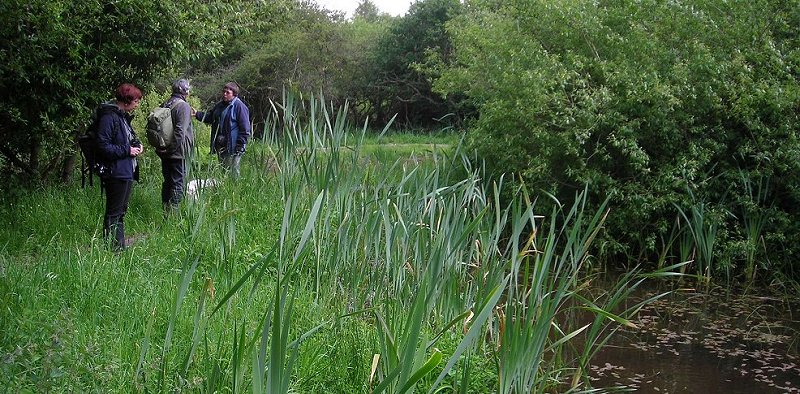
Back to the Home page

Six members met in Kirkby for the trip to Catterick on a not-too-promising morning. However, as we travelled the weather improved and we had sunny intervals for the rest of the day with only the occasional light shower; there was a chilly wind though. We arrived at the entrance to Fox Covert which is part of Catterick Garrison, so you have to pass through military security to obtain a pass and key to the gate. The reserve is bounded by high fences with barbed wire on top but once inside it is very peaceful with a good range of habitats (as it says on its website “The reserve contains semi-natural woodland, heathland, flower-rich grassland, streams, ponds, a lake, willow and alder carr, coniferous woodlands and wet meadows”).
Two more members joined us at the reserve and we proceeded to the education / bird ringing centre (which has some good displays). A team of expert bird ringers were in the middle of catching birds in mist nets then bringing them back to the centre to weigh, measure and ring them before releasing them back outside. We were allowed to hold and release some of the birds which was a real privilege. I had a young coal tit and was amazed just how light it was – and also noticeably warm. The amount of energy required to keep such a tiny creature at that temperature and able to fly must be enormous – no wonder birds have to spend so much time feeding!
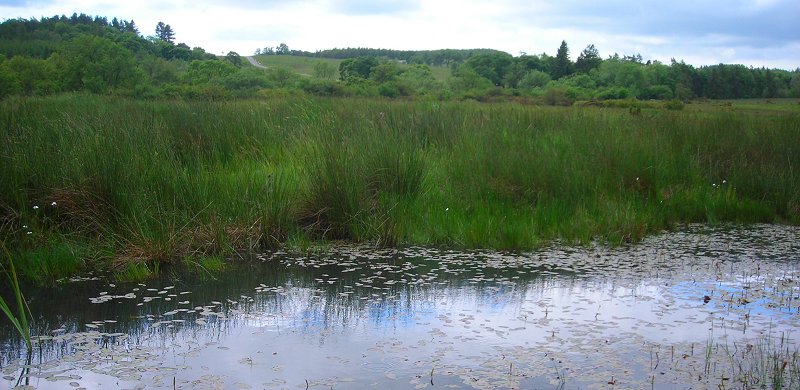
Elizabeth (right) showing us one of the ponds
Elizabeth and Brian from the centre then showed us around the reserve with its mix of ponds, scrapes, wetland, wood, meadow and moor. There were plenty of interesting insects, notably a bright red beetle and the tiny kidney ladybird resting on the trunk of a small ash tree. This ladybird is about the size of the commoner 2-spot and very handsome with its scarlet spots on a shiny black background (see below left).
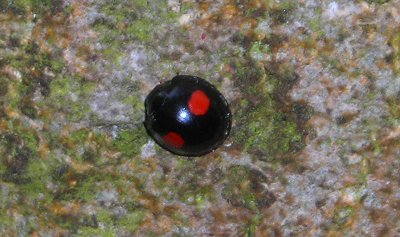
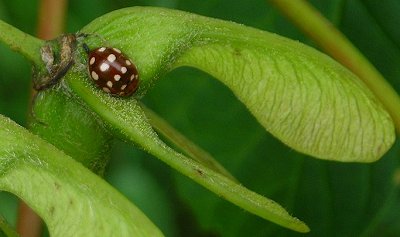
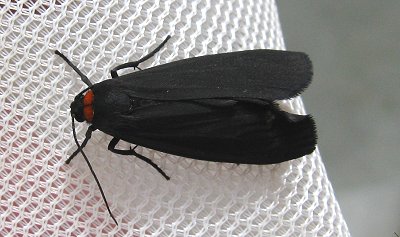
We also saw many other interesting insects including the cream-spot or 14-spot ladybird (above, right), large red damselfly (below, a female), an unfortunate four-spot chaser dragonfly that had emerged but seemed unable to fly, having been in the same place among the reeds for a couple of days and several brightly coloured beetles. One interesting sight was a mass of sawfly larvae munching on a small pine tree; these were later identified by Stuart Dunlop as the pine sawfly Neodiprion sertifer, but the undoubted star of the show was a Red-necked Footman moth (above) that is not only a new record for Foxglove but for VC65. It appears this moth has only started to colonise Yorkshire since 2009.
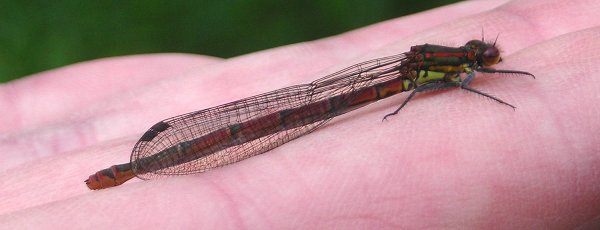
Large red damselfly
There were many interesting plants, including this very pretty pond water crowfoot, marsh cinquefoil, ragged robin – a real pleasure to see it growing in such profusion – and one or two northern marsh orchids. Near one of the ponds there was a thriving colony of the curious little fern Adderstongue. There was a magnificent dryad’s saddle growing on a fallen log on the steep drop down to the beck but few other fungi. I saw a nice little yellow snail and a 1-yr old frog about an inch long. Jim was concentrating on spiders and id’d six species (and there were a few others that were too young to identify).
We thanked our hosts and Jim for arranging a very interesting day, somewhat different from our usual local gathering.
I have just put together a selection of pictures to give some idea of the variety to be seen at this very interesting reserve. A little later in the year there are many more dragonflies to be seen.
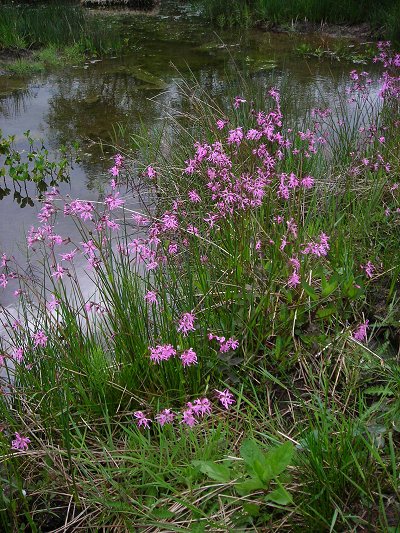 Ragged Robin |
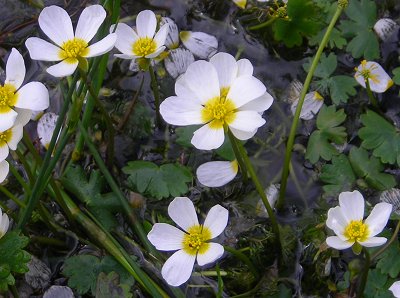 Pond water crowfoot 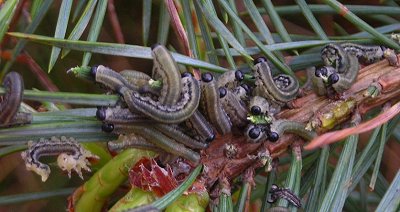 Pine sawfly Neodiprion sertifer |
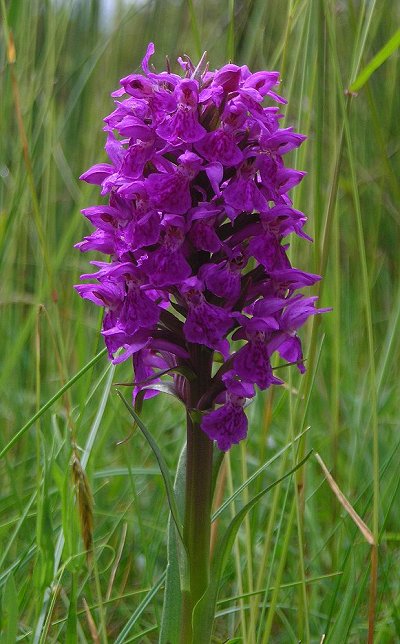 Northern marsh orchid |
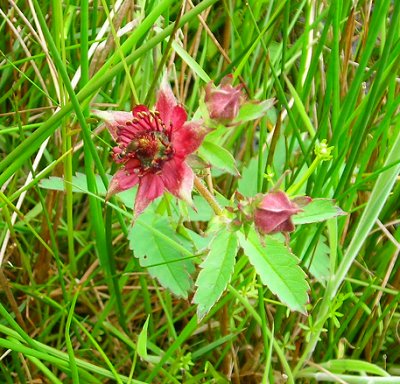 Marsh cinquefoil 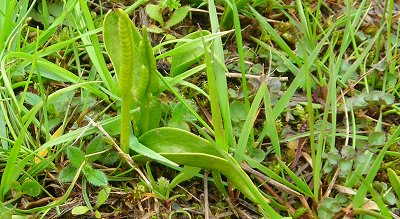 Adderstongue |
Spiders
Clubiona lutescens
Pisaura mirabilis
Xysticus cristatus
Meta mengei
Tetragnatha extensa
Larinioides cornutus
There were two others but due to being young were not identifiable.
Birds Moorhen, Swallow, House Martin, Robin, Song Thrush, Wren, Blackbird, Blue Tit, Great Tit, Greenfinch, Goldfinch, Chaffinch, Tree Sparrow, Willow Warbler, Chiffchaff and in the ringing lab Marsh Tit, Coal Tit and Blackcap. (Thanks, Jim and Keith)
Plants
| English | Latin |
|---|---|
| Adderstongue | Ophioglossum vulgatum |
| Agrimony, common | Agrimonia eupatoria |
| Bedstraw, heath | Galium saxatile |
| Bedstraw, hedge | Galium mollugo |
| Birdsfoot trefoil, common | Lotus corniculatus |
| Birdsfoot trefoil, greater | Lotus pedunculatus |
| Bogbean | Menyanthes trifoliata |
| Bottle sedge | Carex rostrata |
| Bramble | Rubus fruticosus |
| Bugle | Ajuga reptans |
| Bur-reed, common | Sparganium erectum |
| Buttercup, creeping | Ranunculus repens |
| Campion, red | Silene dioica |
| Carnation sedge | Carex panicea |
| Catsear | Hypochaeris radicata |
| Cinquefoil, creeping | Potentilla reptans |
| Cinquefoil, marsh | Potentilla palustris |
| Clover, red | Trifolium pratense |
| Clover, white | Trifolium repens |
| Clover, zigzag | ? Trifolium medium |
| Cocksfoot | Dactylis glomerata |
| Compact Rush | Juncus conglomeratus |
| Cottongrass, common | Eriophorum angustifolium |
| Cranesbill, wood | Geranium sylvaticum |
| Crested Dogstail | Cynosurus cristatus |
| Crosswort | Cruciata laevipes |
| Cuckoo flower or Milkmaid | Cardamine pratensis |
| Daisy | Bellis perennis |
| Dewberry | ? Rubus caesius |
| Fescue, Red | Festuca rubra |
| Field Horsetail | Equisetum arvense |
| Field Madder | Sherardia arvensis |
| Flote grass | Glyceria notata |
| Forgetmenot, changing | Myosotis discolor |
| Forgetmenot, field | Myosotis arvensis |
| Forgetmenot, water | Myosotis scorpioides |
| Foxglove | Digitalis purpurea |
| Glaucous sedge | Carex flacca |
| Hair Grass, Tufted | Deschampsia caespitosa |
| Hawksbeard, marsh | Crepis paludosa |
| Hemp agrimony | Eupatorium cannabinum |
| Herb Robert | Geranium robertianum |
| Lousewort, common | Pedicularis sylvatica |
| Marsh Horsetail | Equisetum palustre |
| Meadow Grass, Rough | Poa trivialis |
| Meadow vetchling | Lathyrus pratensis |
| Milkwort, heath | Polygala serpyllifolia |
| Mint, water | Mentha aquatica |
| Mouse ear, common | Cerastium fontanum |
| Orchid, common spotted | Dactylorhiza fuchsii |
| Orchid, early marsh | Dactylorhiza incarnata |
| Orchid, northern marsh | Dactylorhiza purpurella |
| Oxeye daisy or Dog Daisy | Leucanthemum vulgare |
| Pearlwort, procumbent or mossy | Sagina procumbens |
| Pignut | Conopodium majus |
| Quaking Grass | Briza media |
| Ragged robin | Lychnis flos-cuculi |
| Raspberry | Rubus idaeus |
| Reed | Phragmites communis |
| Reedmace, common | Typha latifolia |
| Self heal | Prunella vulgaris |
| Sharp-flowered Rush | ? Juncus acutifloris |
| Silverweed | Potentilla anserina |
| Slender False Brome | Brachypodium sylvaticum |
| Soft Rush | Juncus effusus |
| Speedwell, brooklime | Veronica beccabunga |
| Speedwell, germander | Veronica chamaedrys |
| Speedwell, heath | Veronica officinalis |
| Speedwell, thyme leaved | Veronica serpyllifolia |
| Speedwell, wall | Veronica arvensis |
| St Johnswort, square stalked | ? Hypericum tetrapterum |
| Star sedge | Carex echinata |
| Stitchwort, bog | Stellaria uliginosa |
| Stitchwort, greater | Stellaria holostea |
| Stitchwort, lesser | Stellaria graminea |
| Stitchwort, marsh | Stellaria palustris |
| Storksbill | Erodium cicutarium |
| Sweet Vernal Grass | Anthoxanthum odoratum |
| Tormentil | Potentilla erecta |
| Valerian, marsh | Valeriana dioica |
| Vetch, bitter | Lathyrus linifolius |
| Vetch, bush | Vicia sepium |
| Vetch, common | Vicia sativa |
| Vetch, tufted | ? Vicia cracca |
| Water Horsetail | Equisetum fluviatile |
| Water crowfoot, pond | Ranunculus aquatilis |
| Woundwort, hedge | Stachys sylvatica |
| Yellow iris or Flag | Iris pseudacorus |
| © Ryedale Natural History Society 2012. Photos © Gill Smith, Keith Gittens 2012 | Back to the Home page |